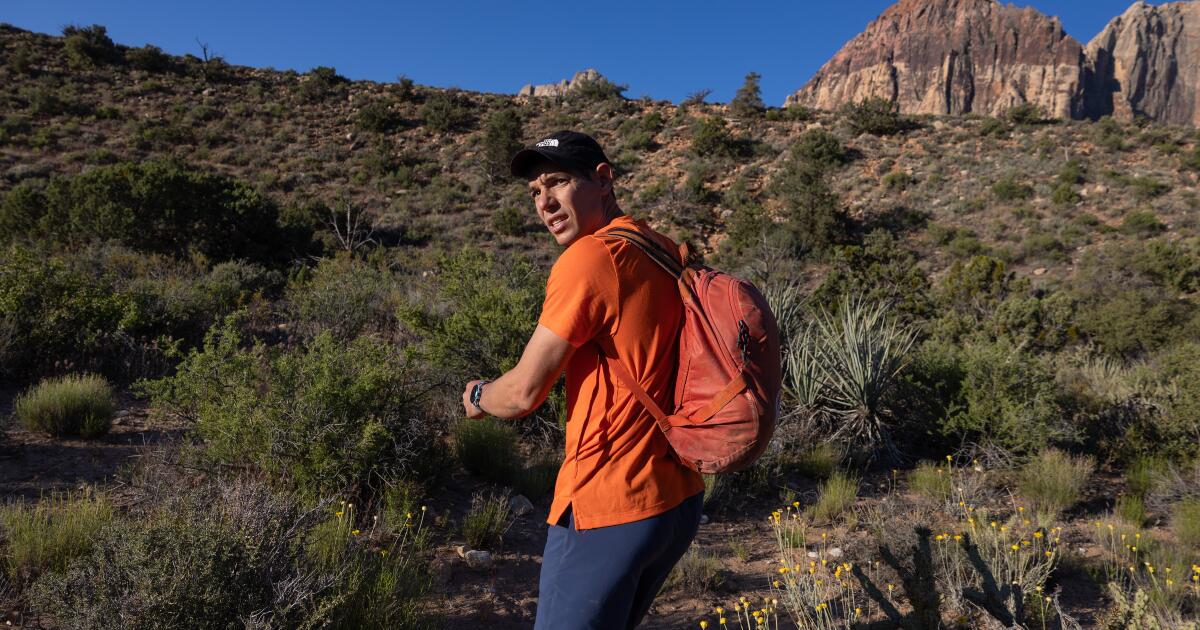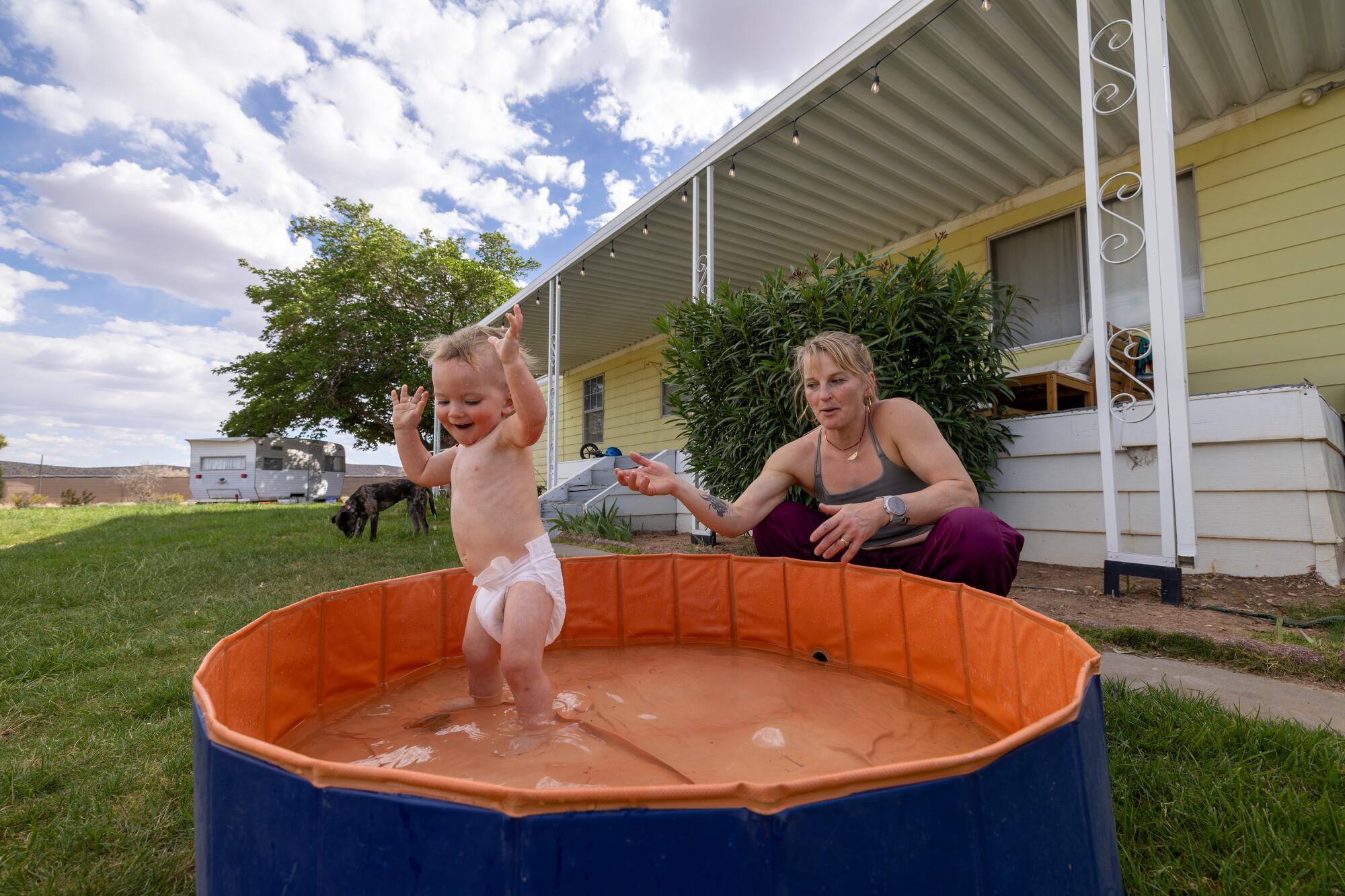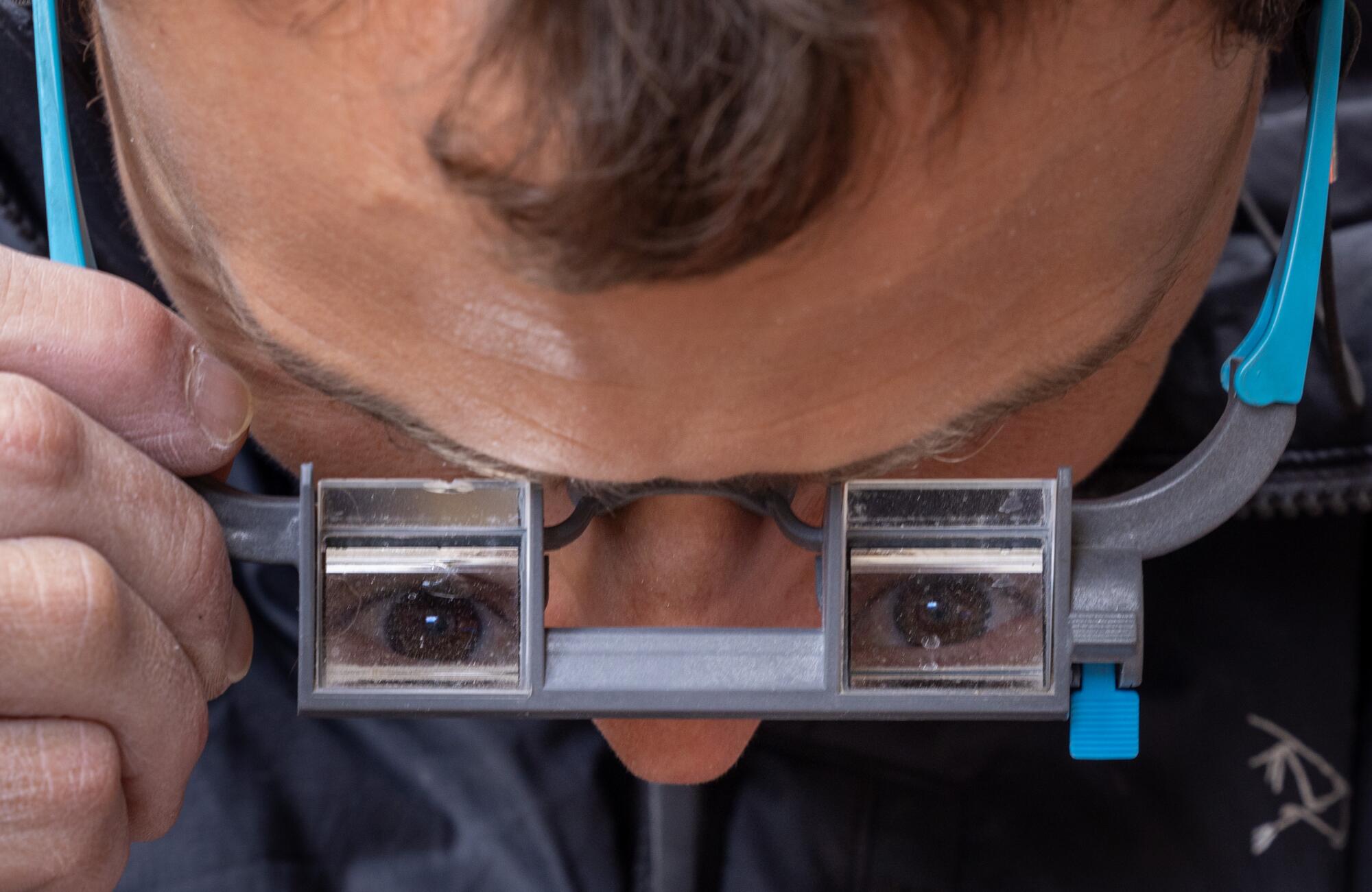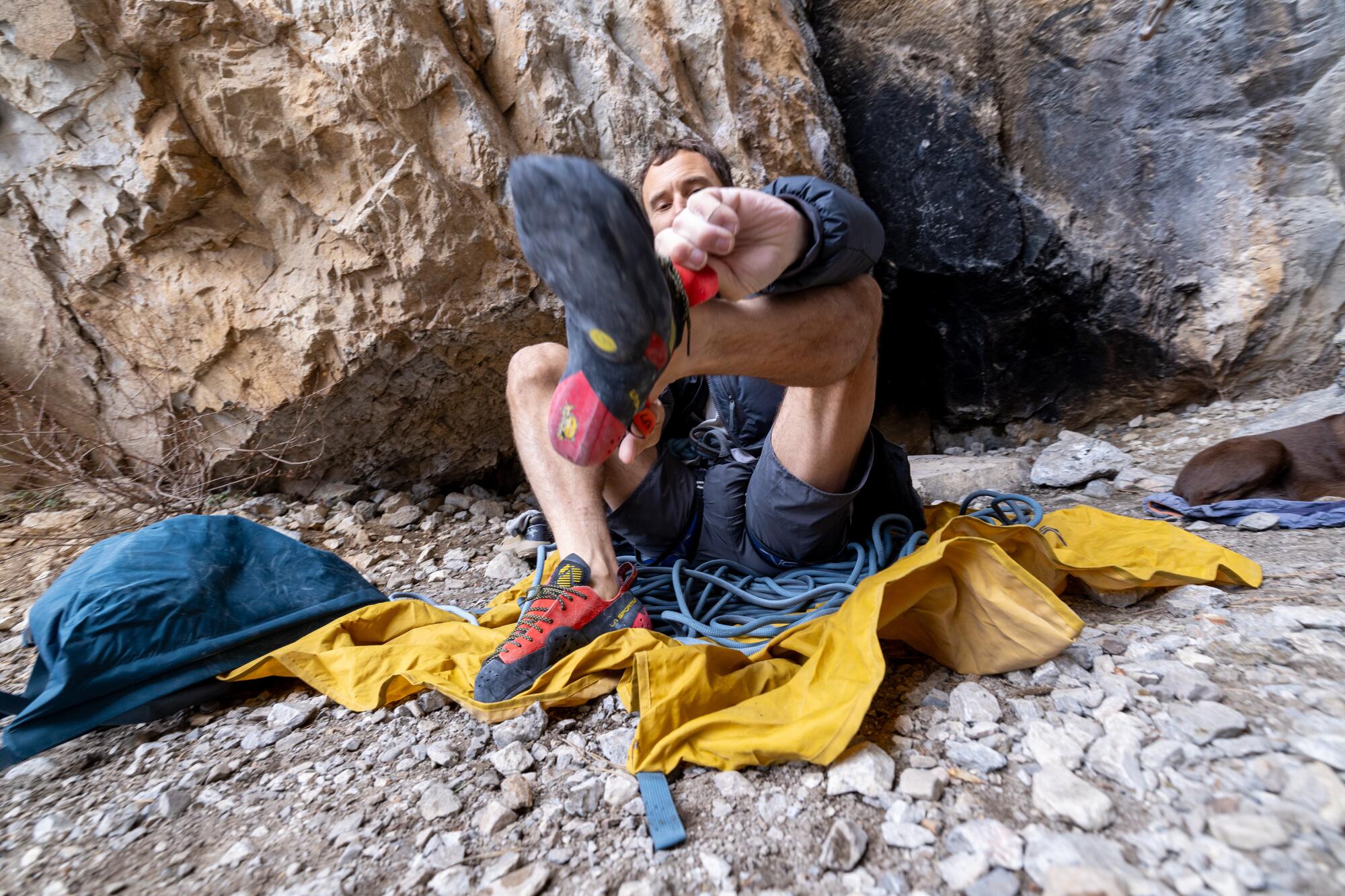Sports
Why some of California's most outdoorsy people are moving to…Las Vegas?

For many, the lure of Las Vegas is the near complete immersion in a man-made world.
Visitors bury themselves deep inside temperature-controlled casinos, surrounded by artificial lights and sounds, with no windows or even clocks to remind them that the outside world still exists.
It’s one of the indoors-iest places on the planet.
But just outside the city, about 20 minutes from the bachelor parties and slot machines, a growing number of elite outdoor athletes are buying homes, starting families and declaring Las Vegas the adventure sports capital of the United States.
Alex Honnold, right, and climbing partner Joey Latina pause on the approach to the Rainbow Wall in Red Rock Canyon just outside Las Vegas.
“It just has unparalleled access to the outdoors,” gushed Alex Honnold, the world’s most famous rock climber and subject of the Academy Award-winning documentary, “Free Solo,” about his breathtaking 2017 ascent of Yosemite’s El Capitan, a nearly vertical granite wall that rises 3,000 feet above the valley floor.
It was first climbed in 1958 by a team who took 18 months searching for tiny protrusions and cracks to use as holds and driving heavy metal spikes into the rock where no natural holds existed. Honnold shocked the climbing world by using only his hands and feet — no safety equipment of any kind — and completing the ascent in just under four hours, a new speed record for the route.
In early May, as light from the rising desert sun seemed to set fire to the towering cliffs of Red Rock Canyon National Conservation Area just west of Las Vegas, Honnold pulled up in his electric truck ready to sprint up another sheer rock face. This one, known as the Rainbow Wall, rose about 1,000 feet above the desert floor.
Honnold, 38, who is of medium height and build and graying slightly at the temples, was dressed in a T-shirt, shorts and running shoes. At first glance, there was little to set him apart from a dozen or so other hikers and climbers lined up to enter the park at 6 a.m.
But then he tossed a small pack over his shoulder and started moving, eager to cover several miles of brush and boulder-strewn landscape between him and the base of the climb before the day got too hot. His small entourage, which included a climbing partner and two Times journalists, struggled to keep up.

Climber Shaina Savoy ascends a limestone wall at Robbers Roost in the Spring Mountains National Recreation Area near Las Vegas.
“Honestly, I would say Las Vegas is better than any of the other cities in the country that have a reputation for being outdoorsy,” Honnold said. “People go to Denver because they say they want to be near the outdoors. But it’s at least an hour’s drive away from the real mountains.”
“In Vegas, you can live in the middle of suburbia and be 15 minutes from trailheads where you can be completely alone and feel like you’re gonna die,” he said as two of his companions hunched over and gasped for breath.
What sets Vegas apart is the unexpected geographic diversity, making world-class climbing easily accessible year-round. In the winter, there are the endless routes in Red Rock, the canyon that begins just beyond the suburbs. Its sandstone walls start at about 3,000-feet elevation, which means they’re low enough to remain warm and pleasant even in December and January.
When spring and summer roll around, and the valley becomes a furnace, 12,000-foot Mt. Charleston is less than an hour’s drive away and the upper reaches can be 30 degrees cooler. There, towering limestone walls offer some of the toughest technical climbs in the world, and there are enough routes to keep a professional climber busy for a lifetime, Honnold said.
Even Yosemite, long regarded as Mecca for rock climbers from all corners of the globe, where Honnold and so many other professionals made their reputations, can’t match that.

The Las Vegas Strip viewed from Red Rock Canyon National Conservation Area about 20 miles west of the city.
“Yosemite is a world destination in the spring and fall,” Honnold said. “But in the summer, it’s way too hot and way too crowded.” And in the winter, at 4,000 feet and directly exposed to Pacific storms, “it’s too wintry.”
And even when the weather is good, day-to-day life for climbers in Yosemite looks more romantic in old documentary films, and on Instagram, than it is in real life. Routes on its biggest and most famous walls, El Capitan and Half Dome, were pioneered by mostly unemployed self-proclaimed “dirtbag” climbers in the late 1950s and early 1960s, who built a fierce and defiant counterculture in the nearby campgrounds.
Among them was Yvon Chouinard, a tinkerer whose small climbing gear business grew into the billion-dollar retailer Patagonia, but who spent years living hand to mouth with fellow climbers in tents and out of their cars. He has told more than one interviewer that, at times during his early climbing days, he was so broke he subsisted on canned cat food because, “it was better than dog food.”
That underlying ethos had mellowed a bit, but still existed when Honnold first drove the family minivan down from Sacramento in the early 2000s. He was still living in a van in 2017 when he made the career-defining climb of El Capitan.
But ask anyone who has done it for long and they’ll tell you, van life gets old, even in a place as beautiful as Yosemite.

Emily Harrington says climbers of her generation are looking to buy homes and settle down. She and her husband recently had a son, Aaro, adding urgency to their quest.

Hot showers. Good climbing. Great food. Climber Emily Harrington’s joy and relief are palpable as she lists the upsides of moving to the Las Vegas suburbs with her husband and son.
Emily Harrington, a five-time U.S. national champion in sport climbing and one of Honnold’s good friends, knows it all too well.
“Yosemite is just a hard place to exist,” she said. You spend all day pushing yourself to mental and physical exhaustion on the climbing walls, but there’s no rest when you come down. You have to find a place to camp, or park the van, or drive the van on long, crowded, windy roads to find a place outside the park. And even when you find a place, you’re still stuck in a van.
“It’s quite stressful,” Harrington said.
At 37, Harrington says climbers of her generation are looking to settle down. She and her husband, fellow climber Adrian Ballinger, recently had a son, which added real urgency to their quest.
That’s why they bought a place in Vegas not far from Honnold, his wife and their two young kids.
Harrington’s joy and relief are palpable as she lists the upsides of the new arrangement. “I can go out, drive five minutes to the trailhead, climb big routes all day, and then come back to my house and my kid and put him to bed, and I don’t have to live in a van!”
Hot showers. Soft beds. Great food. She rattled off about half a dozen of her favorite restaurants that are only a few minutes away. “It’s just so nice,” she said.
Jonathan Siegrist, 38, who is regarded as one of the world’s greatest technical climbers, couldn’t agree more.
While Honnold was battling the Rainbow Wall and nearly 90 degree heat in Red Rock last week, Siegrist and his wife, Shaina Savoy, huddled in puffy jackets between pitches on the cool limestone of nearby Mt. Charleston.

Jonathan Siegrist tackles Robbers Roost, a world-class rock-climbing destination in the Spring Mountains National Recreation Area.

Jonathan Siegrist wears belay glasses, which give climbers a 90-degree view without craning their neck, during a climb at Robbers Roost.
Siegrist is unassuming when you first meet him: 5-foot-6, a firm handshake, a friendly smile. But then he pulls off his warm outer layer and starts climbing. Supporting his entire body with just his fingertips and the points of his toes on microscopic holds, he ascends the wall in precise choreographed movements, his progress as fluid and inevitable as flowing lava.
Despite the intense effort, which would leave most people gasping and single-minded, Siegrist had the aerobic and mental capacity to carry on a normal conversation.
He lived in his truck, off and on, for seven years. He settled down in Vegas because the climbing is better than anywhere else in the country and because the cost of living is much more reasonable than trendier climbing spots like his hometown of Boulder, Colo.
Even so, he struggles to convince young climbers, who are still trying to make names for themselves, that Vegas is the place to be.
“This city still has a really bad reputation in the outdoor community,” he said. “A lot of outdoor people would never stoop so low as to walk into a casino and enjoy themselves, or shop at a strip mall,” he said. “That’s a huge contributing factor as to why Vegas has stayed under the radar.”

After living in his truck for years, Jonathan Siegrist said he settled in Las Vegas because the climbing is great and the cost of living more reasonable than in many trendy mountain towns.
But it’s actually one of the perks, he said.
Fashionable mountain towns are full of people trying to fit in, Siegrist said, to conform to a pretty strict outdoorsy aesthetic. They tend to look, dress and think the same way.
Freedom from that is one of the things he loves about Vegas.
“I’m not just talking about racial diversity. I’m talking about economic diversity, diversity of ideas and diversity of interests,” he said. On rest days, when he’s not climbing, “I can be a totally different version of myself.”
The difference can show in something as simple as walking his dogs off leash. If he tries that in Boulder, where his parents still live, “I’ll get yelled at by, like, six people in the first 30 seconds, even though the dogs are really obedient,” he said.
In Vegas, “nobody gives a s— what your dogs are doing as long as they’re not hurting anyone.”
Honnold, whose parents were teachers and who supports strong public services, confessed he, too, was pleasantly surprised by the lower cost of living in Nevada.
“I mean, there’s no income tax! And the house was so cheap, it nearly paid for itself in tax savings,” he said. All those years on the road, living in vans, he had listed his mom’s house in Sacramento as his address.
“That was crazy,” he said, “I was like, why didn’t I move to Vegas sooner?”

Sunrise at Red Rock Canyon National Conservation Area.
The Vegas airport is another huge draw for people whose profession demands they travel the world in search of adventure. It’s 20 minutes from Honnold’s house, the security lines are usually a breeze and, because of all the tourists, it has direct flights almost anywhere you’d want to go.
One day, when he was splitting time between training and promoting “Free Solo,” he climbed a 2,000-foot wall in the morning, showered at home, then caught a noon flight to London.
“Where else in the world can you do that?” he asked.
But what about that other side of Vegas, the strip? Honnold said he and his wife go there once or twice a year to catch a show and otherwise avoid it as much as possible.
Does he ever sit down at a slot machine and start pulling the lever?
“If a game is designed for you to lose, why play?” he asked. “I’ve actually never tried it. I like to joke that I only gamble with my life.”

Sports
Teenage MLB prospect Frank Cairone hospitalized after car crash

NEWYou can now listen to Fox News articles!
Top Milwaukee Brewers prospect Frank Cairone was hospitalized after being involved in a serious car accident near his New Jersey home on Friday, the team announced.
“Frank is currently being cared for at a hospital in New Jersey with the support of his family,” read a statement from the team, via MLB.com. “The Brewers’ thoughts and prayers are with Frank and his family during his difficult time.”
Pitcher Frank Cairone (left) with Green Valley High School (NV) infielder Caden Kirby during the MLB Draft Combine high school baseball game at Chase Field. (Mark J. Rebilas/Imagn Images)
The left-handed pitcher turned 18 this past September. He was drafted out of Delsea Regional High School in Franklinville, N.J. at No. 68 overall in the 2025 Draft.
News of the Brewers’ young prospect’s accident came shortly after the team announced it was not in contact with several players in Venezuela after U.S. military strikes in the country and the capture of its President Nicolás Maduro.
MLB TEAM UNAWARE OF STATUS OF PLAYERS IN VENEZUELA AFTER US MILITARY STRIKES
Milwaukee Brewers outfielder Jackson Chourio (11) is seen before the fifth inning of an MLB game between the Milwaukee Brewers and the Toronto Blue Jays on August 31, 2025, at Rogers Centre in Toronto, ON. (Mathew Tsang/Icon Sportswire via Getty Images)
Brewers president of baseball operations Matt Arnold revealed the team is unaware of the status of the players in a statement Saturday.
“We don’t have much info at the moment but are trying to follow up,” Arnold said, via the Milwaukee Journal Sentinel. “We know the airports have been shut down but not much beyond that.”
CLICK HERE TO DOWNLOAD THE FOX NEWS APP
Pitcher Frank Cairone during the MLB Draft Combine high school baseball game at Chase Field. (Mark J. Rebilas/Imagn Images)
The team’s players in Venezuela include star outfielder Jackson Chourio, infielder Andruw Monasterio and catcher Jeferson Quero, according to the outlet.
Follow Fox News Digital’s sports coverage on X, and subscribe to the Fox News Sports Huddle newsletter.
Sports
City Section boys’ basketball has nowhere to go but up after hitting rock bottom

It might be time to write a folk song about the demise of City Section basketball using the music of Peter, Paul and Mary and the new title, “Where Have All the Players Gone?”
The talent level clearly has hit rock bottom only a year after Alijah Arenas was a McDonald’s All-American at Chatsworth High and Tajh Ariza led Westchester to the City Section Open Division title. Because their parents went to City Section schools, Arenas and Ariza stuck it out. Then Arenas graduated early to join USC and Ariza left for St. John Bosco, then prep school.
Westchester is where Ed Azzam won 15 City titles in 42 seasons until his retirement in 2021. Crenshaw is where Willie West won 16 City titles and eight state titles. Taft is where Derrick Taylor won four City titles and coached future NBA players Jordan Farmar, Larry Drew II and AJ Johnson. Fairfax is where Harvey Kitani coached for 35 years, won four City titles and two state titles and earned most of his nearly 1,000 victories. He was followed by Steve Baik and Reggie Morris Jr., each of whom won City championships before leaving.
None of the City schools once considered among the best in Southern California are even close to resembling their glory days, and they aren’t alone. The City Section has lost most of its talent, and it was truly Hall of Fame talent: Marques Johnson and John Williams at Crenshaw; Gail Goodrich at Sun Valley Poly; Willie Naulls at San Pedro; Dwayne Polee at Manual Arts; Gilbert Arenas at Grant; Trevor Ariza at Westchester; Chris Mills at Fairfax. There were decades of success.
There’s no one person to blame. You can’t even place the downfall solely on the Los Angeles Unified School District, whose high schools compete in the City Section.
But LAUSD has done nothing to reverse the trend and didn’t help matters by opening so many new schools in such rapid fashion that longtime legacy schools lost their luster amid declining student enrollment. Things became even more disruptive by the rise of charter schools and private schools taking away top athletes. Adding to that, the loss of veteran coaches frustrated by bureaucracy issues and rules that force programs to secure permits and pay to use their own gyms in the offseason helped further the exodus.
Westchester is 2-8 this season and an example of where City Section basketball stands. Two top players from last season — Gary Ferguson and Jordan Ballard — are now at St. Bernard. Westchester doesn’t even have a roster posted on MaxPreps. King/Drew won its first City Open Division title in 2024 under coach Lloyd Webster. This season Webster sent his senior son, Josahn, to Rolling Hills Prep to play for Kitani. King/Drew is 4-10.
Charter schools Birmingham, Palisades and Granada Hills have separated themselves in virtually all City Section sports including basketball. They have no enrollment boundaries as long as there’s a seat for a student. Palisades lost so many students after the wildfire last year that transfers have been big additions for its teams this school year. Online courses are being offered to help students enroll and compete in sports at charter schools.
The old powers from the inner city — Crenshaw, Dorsey, Jefferson, Locke and Fremont — experienced big changes in demographics. Many coaches are walk-ons and not teachers. The legacy schools have to compete with charter schools View Park Prep, Triumph, Animo Watts, Animo Robinson, WISH Academy and USC-MAE. When young players are discovered and developed, rarely will they stay when one of the private schools or AAU coaches searching for talent spots them in the offseason.
So what’s left? Not much.
Palisades, Washington Prep and Cleveland look like the three top teams this season. All three added transfers to help buck the downward trend. And yet their records are 3-10, 8-8 and 7-6, respectively, against mostly Southern Section teams.
Maybe this can be a fluke one-year plunge to the bottom and the climb back up can begin, aided by coaches who recognize their job is to teach lessons in basketball, life and college preparation. Parents need a reason to send their kids to a City Section school. It’s up to LAUSD and principals to help change the trajectory by finding coaches with integrity, passion and willingness to embrace the underdog role.
There are plenty in the system doing their best. It’s time to start hearing and answering their pleas for help.
Sports
Seahawks secure top seed in NFC with dominant road win over 49ers

NEWYou can now listen to Fox News articles!
The Seattle Seahawks locked down the top seed in the NFC playoffs and a strong path to the Super Bowl on Saturday night with a season finale win over the San Francisco 49ers.
Seattle also finished with their best regular season record in franchise history, clinching 14 wins for the first time ever.
The Seahawks held on to a 10-point victory despite outgaining the 49ers 363 yards to 173, and running 64 plays to San Francisco’s 42.
Jaxon Smith-Njigba #11 of the Seattle Seahawks fails to catch the ball against Ji’Ayir Brown #27 of the San Francisco 49ers during an NFL game on Jan. 3, 2026 at Levi’s Stadium in Santa Clara, California. (Matthew Huang/Icon Sportswire)
Seattle missed a field goal in the fourth quarter and turned the ball over on downs in the first quarter to waste two red zone drives, but dominated on defense to prevent those missed opportunities from coming back to haunt them.
The 49ers wasted their best drive of the night as well when quarterback Brock Purdy was intercepted at Seattle’s three-yard line in the fourth quarter facing a 10-point deficit, which seemingly secured the game for the Seahawks.
NFL WEEK 17 SCORES: AFC NORTH, NFC SOUTH UP FOR GRABS AS PLAYOFF PICTURE ALMOST COMPLETE
Seahawks quarterback Sam Darnold, in his first season on the team, completed 20 passes on 26 attempts for 198 yards and helped set up the only touchdown of the entire game in the first quarter.
Darnold redeemed a disappointing Week-18 game for the Minnesota Vikings last season when he completed just 18 of 41 passes for 166 yards in a battle for the top seed against the Detroit Lions.
Darnold said “Learning from mistakes, and staying calm from the pocket,” made the difference in his performance Saturday compared to a year ago, in a postgame interview with ESPN.
CLICK HERE TO DOWNLOAD THE FOX NEWS APP
Jaxon Smith-Njigba #11 of the Seattle Seahawks carries the ball against the San Francisco 49ers during the second quarter of a game at Levi’s Stadium on January 03, 2026 in Santa Clara, California. (Ezra Shaw/Getty Images)
Meanwhile, 49ers quarterback Brock Purdy had just 127 yards with the late interception, and took a big hit on his final pass of the night, then took a while to get back up. He was eventually able to walk off the field, and Seattle ran the clock out.
Follow Fox News Digital’s sports coverage on X, and subscribe to the Fox News Sports Huddle newsletter.
-

 Entertainment1 week ago
Entertainment1 week agoHow the Grinch went from a Yuletide bit player to a Christmas A-lister
-

 World7 days ago
World7 days agoHamas builds new terror regime in Gaza, recruiting teens amid problematic election
-

 Indianapolis, IN1 week ago
Indianapolis, IN1 week agoIndianapolis Colts playoffs: Updated elimination scenario, AFC standings, playoff picture for Week 17
-

 Southeast1 week ago
Southeast1 week agoTwo attorneys vanish during Florida fishing trip as ‘heartbroken’ wife pleads for help finding them
-

 Business1 week ago
Business1 week agoGoogle is at last letting users swap out embarrassing Gmail addresses without losing their data
-

 World1 week ago
World1 week agoBest of 2025: Top five defining moments in the European Parliament
-

 World1 week ago
World1 week agoSnoop Dogg, Lainey Wilson, Huntr/x and Andrea Bocelli Deliver Christmas-Themed Halftime Show for Netflix’s NFL Lions-Vikings Telecast
-

 News1 week ago
News1 week agoDOJ says it may need a ‘few more weeks’ to finish releasing Epstein files



















